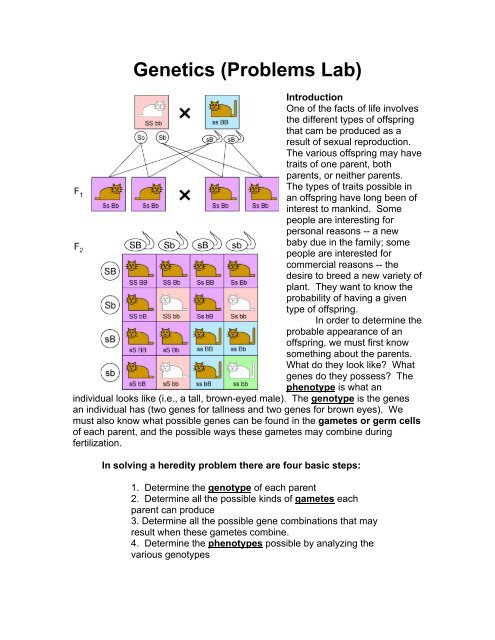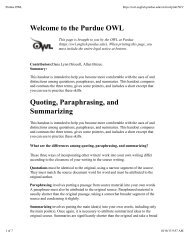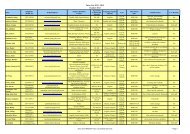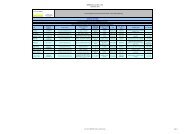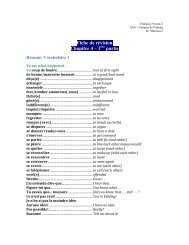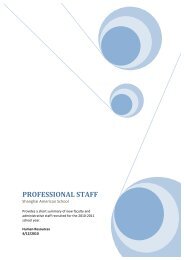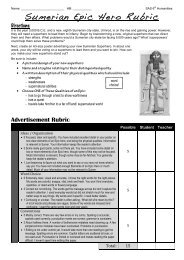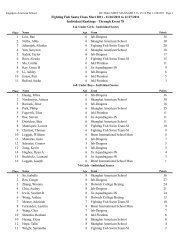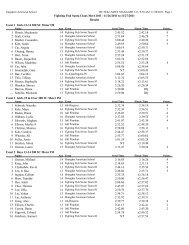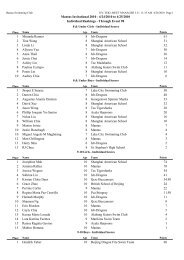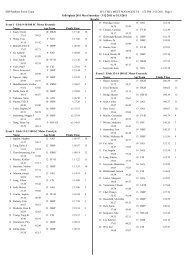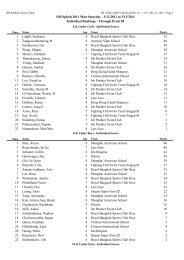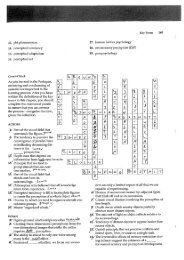Genetics (Problems Lab)
Genetics (Problems Lab)
Genetics (Problems Lab)
Create successful ePaper yourself
Turn your PDF publications into a flip-book with our unique Google optimized e-Paper software.
<strong>Genetics</strong> (<strong>Problems</strong> <strong>Lab</strong>)<br />
Introduction<br />
One of the facts of life involves<br />
the different types of offspring<br />
that cam be produced as a<br />
result of sexual reproduction.<br />
The various offspring may have<br />
traits of one parent, both<br />
parents, or neither parents.<br />
The types of traits possible in<br />
an offspring have long been of<br />
interest to mankind. Some<br />
people are interesting for<br />
personal reasons -- a new<br />
baby due in the family; some<br />
people are interested for<br />
commercial reasons -- the<br />
desire to breed a new variety of<br />
plant. They want to know the<br />
probability of having a given<br />
type of offspring.<br />
In order to determine the<br />
probable appearance of an<br />
offspring, we must first know<br />
something about the parents.<br />
What do they look like? What<br />
genes do they possess? The<br />
phenotype is what an<br />
individual looks like (i.e., a tall, brown-eyed male). The genotype is the genes<br />
an individual has (two genes for tallness and two genes for brown eyes). We<br />
must also know what possible genes can be found in the gametes or germ cells<br />
of each parent, and the possible ways these gametes may combine during<br />
fertilization.<br />
In solving a heredity problem there are four basic steps:<br />
1. Determine the genotype of each parent<br />
2. Determine all the possible kinds of gametes each<br />
parent can produce<br />
3. Determine all the possible gene combinations that may<br />
result when these gametes combine.<br />
4. Determine the phenotypes possible by analyzing the<br />
various genotypes
Purpose<br />
In this exercise you will be asked to determine the probable type of offspring<br />
when given the necessary genetic information. You will also be asked to arrive<br />
at the genotype of the parents and their offspring.<br />
During this exercise you will be:<br />
1. Working monohybrid problems<br />
2. Working dihybrid problems<br />
3. Determining genotypes and pheonotypes of parents and offspring<br />
Put your answers on your answer sheet. And with all problems, be sure to<br />
show ALL of your work. Make your legends complete and easy to follow!<br />
PART I: Monohybrid <strong>Problems</strong>- (One trait being followed from one<br />
generation to the next.)<br />
1. In humans, six fingers (F) is the dominant trait, and five fingers (f) is the<br />
recessive trait. Both parents are heterozygous for six fingers. What is the<br />
phenotype of the father and the mother? What is the genotype of each parent?<br />
What is the probability of them having six-fingered children? Five-fingered<br />
children?<br />
Father's phenotype (1a) Mother’s phenotype (1b)<br />
Father's genotype (1c) Mother’s genotype (1d)<br />
Father's germ cells __or __(1e)<br />
Mother's germ cells __or __(1f)<br />
Probability of a six-fingered child (1g)<br />
Probability of a five-fingered child (1h)<br />
2. If the father is heterozygous for six fingers and the mother has five fingers,<br />
what is the probability of having these characteristics in the offspring? Six fingers<br />
(2a) Five fingers (2b)<br />
3. In certain flowers, color is inherited by genes that have incomplete<br />
dominance. In such flowers, a cross between a homozygous white and a<br />
homozygous red will always result in a pink flower. A cross is made between<br />
two pink flowers. What is the probability of these colors (red, pink and white)<br />
appearing in the offspring? (3a)<br />
4. Use the information given in the problem number 3. A cross is made between<br />
a red flower and a pink flower. What will be the expected probability for the<br />
various colors? (4a)
PART II: Dihybrid <strong>Problems</strong> - (Two traits being followed from one<br />
generation to the next)<br />
5. In horses, black color (B) dominates chestnut color (b). The trotting gait (T)<br />
dominates the pacing gait (t). A cross is made between a horse homozygous for<br />
black color and the pacing gait and a horse homozygous for chestnut color and<br />
the trotting gait. List the probable phenotypes of offspring that could result if the<br />
offspring from the original cross were crossed among themselves.<br />
Original cross: genotype (5a) phenotype (5b)<br />
Cross of the offspring. (Handle this like a separate problem. Take who<br />
individuals from the original cross.) (5c)<br />
6. Humans may have Rh+ blood or Rh- blood. A person with Rh+ blood or Rh-<br />
does not have this particular protein in his blood. In humans, Rh positive blood<br />
dominates Rh negative blood. Normal insulin production dominates abnormal<br />
insulin production (diabetes). If both parents are heterozygous for Rh positive<br />
blood and normal insulin production, what probable phenotypes would they<br />
produce with these traits? (6a)<br />
7. For this problem use the information concerning the traits given in problem 6.<br />
The father is homozygous for Rh-positive blood and has diabetes. The mother<br />
has Rh negative blood and is homozygous for normal insulin. What probable<br />
phenotypes would they produce with these traits? (7a)<br />
8. In the radish plant the long and round traits are incompletely dominant and<br />
result in an oval shape. The red and white color traits are incompletely dominant<br />
and result in a purple color. Two plants both oval-shaped and purple are<br />
crossed. What would be the phenotypic ratio in their offspring? (8a)<br />
9. In certain breeds of dogs, black color is dominant and red color is recessive,<br />
solid color is dominant and spotting is recessive. A homozygous black and white<br />
spotted male is crossed with a red and white spotted female. What is the<br />
probability of them producing a solid black puppy? (9a)<br />
10. In humans, there is a type of blindness due to a dominant gene; normal<br />
vision is the result of a recessive gene. Migraine headaches are due to a<br />
dominant gene, and normal (no headaches) is recessive. A male who is blind<br />
and does not suffer from headaches marries a woman who has normal vision<br />
and suffers from migraines. Could they produce a child with normal vision and<br />
does not suffer from headaches? (10a) If yes, can the probability of such a child<br />
be determined? (10b)
PART III: Linked trait <strong>Problems</strong> - (Genes located on one chromosome that<br />
affect different traits)<br />
11. In humans, the condition for normal blood clotting dominates the condition<br />
for nonclotting (hemophilia). Both genes are linked to the X chromosome. A<br />
male hemophiliac marries a woman who is a carrier for this condition. (In this<br />
respect, a carrier is a woman who has a gene for normal blood clotting and a<br />
gene for hemophilia.) What are the chances that if they have a male child he will<br />
be normal for blood clotting? (11a)<br />
12. For this problem use the information given in problem 11. A male who has<br />
normal blood clotting marries a woman who is a carrier for this condition. What<br />
are the chances that if they have a son he will be normal for blood clotting? (12a)<br />
13. In humans, the condition for normal vision dominates color blindness. Both<br />
genes are linked to the X chromosome. A color-blind male marries a color blind<br />
female. If they have a daughter, what are the chances that she will have normal<br />
vision? (13a)<br />
14. For this problem use the information given in problem 13. A normal-visioned<br />
male marries a color-blind woman. She gives birth to a color-blind daughter.<br />
The husband claims the child is not his. The wife claims the child is his. Can<br />
you support the argument of either parent? (14a) If yes, which one? (14b) Why?<br />
(14c)<br />
PART IV: Multiple Allele <strong>Problems</strong> - (Characteristics which have more than<br />
two possible alleles forms)<br />
15. In humans, the trait for A type blood and B type blood show incomplete<br />
dominance, so that a person with both genes has blood type AB. Both A and B<br />
dominate type O. A person with a gene for type O blood marries someone with a<br />
gene for type B blood and type O blood. List the types of offspring they could<br />
have and the probability for each blood type in the offspring. (15a)<br />
16. For this problem use the information given in problem 15. A young lady with<br />
type O blood gave birth to a baby with type O blood. In a court case she claims<br />
that a certain young man is the father of her child. The man has type A blood.<br />
Could he be the father of the child? (16a) Can it be proven on this evidence<br />
alone that he is the father? (16b)<br />
17. In humans, nappy (kinky) hair, curly hair, wavy hair, and straight hair are<br />
dominant in that order. Dark hair dominates red hair. A wavy, red-haired male,<br />
who had a straight dark-haired mother, marries a straight, dark-haired female,<br />
who had a curly red haired father. What type of children can they produce and<br />
what is the probability of producing these types of offspring? (17a)
18. Normal pigmentation dominates no pigmentation (albino). In order for an<br />
organism to exhibit color, it must have a gene for normal pigment production as<br />
well as genes for a specific color. In cattle red color dominates black. An albino<br />
bull that has a heterozygous genotype for red is crossed with a red cow. The<br />
cow is heterozygous for normal pigment production and for red coloring. What<br />
types of offspring will they produce and what will be the probability for producing<br />
these types of offspring? (18a)<br />
Note: All the polygenic inheritance problems in this exercise involve two different<br />
traits; therefore, they are all dihybrid problems.<br />
19. In some types of wheat, color is caused by two sets of genes. Both<br />
dominant genes, R and B are needed for red color. White results from both<br />
recessive genes in the homozygous state, rrbb. Any other combination will<br />
produce brown wheat grains. A strain with a genotype of Rrbb is crossed with a<br />
strain of wheat with a genotype of rrBb. What is the color of each of the parent<br />
strains? (19a) What color wheat will result from this cross and what is the<br />
probability for each color? (19b) Rrbb color _______rrBb color_______<br />
20. In humans, normal pigmentation dominates no pigmentation (albino). Black<br />
hair dominates blonde hair. An albino person will have white hair color even<br />
though they may also have the genes for black or blonde hair color. An albino<br />
male who is homozygous for black hair marries a woman who is heterozygous<br />
for normal pigmentation and who has blonde hair. What colors of hair can their<br />
children have and what is the probability for each hair color? (20a)<br />
Determination of Genotypes- (what you see and what you get.) Not all types of<br />
heredity problems deal with determining the phenotype of the offspring. There is<br />
a type of problem where the phenotypes of both of the parents and the offspring<br />
are known and you wish to determine the genotype of each individual.<br />
In humans, brown eyes are dominant and blue eyes are recessive. Two browneyed<br />
people marry and produce one brown-eyed child and two blue-eyed<br />
children. What is the genotype of the parents and each of the children?<br />
Since the parents are both brown-eyed, they must have at least one gene for<br />
brown eyes so their genotypes would be B____ (the ___ means the gene could<br />
be either the dominant allele or the recessive allele). The genotype for the blueeyed<br />
children must be bb. Since each parent contributed one gene to each blueeyed<br />
offspring, you know that each brown-eyed parent has a gene for blue eyes.<br />
Therefore, the ___ must be a b and the genotype for each parent is Bb. All you<br />
know about the brown-eyed offspring is that it has one gene for brown eyes, the<br />
genotype could be BB or Bb.
In the remaining problems, attempt to determine the genotypes of the individuals.<br />
Take it slowly, only put down a gene when you are certain the individual has that<br />
gene. If you are not certain, merely show that you don't know by leaving a blank<br />
____.<br />
21. Normal pigmentation (A) dominates no pigmentation (albino=aa) Brown eyed<br />
coloring (B) dominates blue-eyed coloring (bb). Two people with normal<br />
pigmentation produce one brown eyed, and two blue eyed, and two albino<br />
children. What is a possible genotype for the parents? (21a)<br />
22. A red bull when crossed with white cows always produces roan colored<br />
offspring. Explain how the colors for red, white, and roan are inherited. (22a)<br />
23. In rabbits, short hair is due to a dominant gene L, and long hair to its<br />
recessive allele I. Black fur is due to a dominant gene B, and white hair to its<br />
recessive allele b. When two rabbits were crossed they produced 2,518 shorthaired<br />
black and 817 long-haired black offspring. What are the probable<br />
genotypes of the parents? (23a)<br />
24. In humans, the condition for normal blood clotting dominates hemophilia.<br />
Both genes are sex-linked to the X chromosome. Two parent produced<br />
daughters who are all carriers and sons who are all normal. What are the<br />
probable genotypes of the parents? (24a)<br />
25. In humans, deafness is due to a homozygous condition of either or both<br />
recessive genes d and e. Both the dominant genes D and E are who all have<br />
normal hearing. What are the probable genotypes of the children and parents?<br />
(25a)


